#thinking ab how funny this disparity is
Explore tagged Tumblr posts
Text
Soundwave speaks in the 3rd person and no one blinks. He’s intelligent, respected even
But when Me, Grimlock-
#thinking ab how funny this disparity is#soundwave said fuck the first person fuck articles and fuck prepositions#it’s HIS silly little speech pattern and it has no room for this ‘grammar’ nonsense#grimlock however is written off as dumb for doing the same damn thing#I feel like grim could use him as a role model#transformers#maccadam#soundwave#grimlock#I hope everyone reads this in the voice of that one joker ‘SoCiEtY’ gay meme
2K notes
·
View notes
Text


[cis woman andWelcome to Aurora Bay, ESTHER CLEMENTS! I couldn’t help but notice you look an awful lot like GRACE VAN PATTEN. You must be the TWENTY-FIVE year old ATTENDANT AT COOLDOWN ICE RINK. Word is you’re ARTICULATE but can also be a bit COMPLACENT and your favorite song is ANTHEMS FOR A SEVENTEEN YEAR OLD GIRL by BROKEN SOCIAL SCENE. I also heard you’ll be staying in OCEAN CREST APARTMENTS. I’m sure you’ll love it! Trigger Warnings: minor mention of drugs
basic stats
Full Name: Esther Mallory Clements
Nickname(s): Estie, Est
Gender: Cis woman (she/her)
Sexuality: Heterosexual
Birthday: April 27, 1999
Hometown: Aurora Bay, CA
Current Residence: Ocean Crest Apartments
Time in AB: All her life
Occupation: Attendant at Cooldown Ice Rink
Education: High School Diploma
Religion: None
Pets: A 3-year-old orange tabby named Argyle
Family: Susan Argyle (mom), Mitchell Clements (dad), Bonnie Foster-Goldstein Clements (stepmom), Megan Clements (older sister), Ethan Clements (younger brother), Michael Foster-Goldstein (stepbrother)
Faceclaim: Grace Van Patten
Hair Color: Naturally dark brown, dyed blonde
Eye Color: Dark brown
Height: 5'5
Tattoos: tba
Piercings: Three in each ear
Favorite Movie: Interstellar
Favorite Alcoholic Drink: Pinot Grigios
Favorite Food: Cheeseburgers
headcanons
Her step-mom's full name is Bonnie Foster-Goldstein Clements. Foster is her maiden name and Goldstein is her previous husband's last name. When Estie found out Bonnie was keeping her first husband's last name she busted out laughing and that really laid the foundation for their mutual hatred. Esther also gave Bonnie's son, Michael, his first joint when he was 12 and she still brings it up to this day even though it was almost ten years ago
Esther has a cat named Argyle. Argyle is Esther's mom's maiden name, which she notoriously changed back to during her messy divorce. When Esther went to find a cat to adopt, she found an orange tabby named Argyle and thought it was so funny she kept that as the name
Hates cooking but finds baking very therapeutic and is obsessed with making bread
Has loved ice skating since her mom tried to sign her up for a class when she was eight. She hated the class but loved the skating. Her mom forced her to keep taking them for a few years until she finally flat out refused, but she's always kept practicing on her own time. She's not fantastic or anything because she hasn't actually been formally trained beyond those few years but she's pretty good and most of all she finds it really meditative just skating around the rink for a couple hours
Loves absolutely all kinds of music and obsessively tracks what she listens to on Last.fm
Every firstborn daughter on her mom's side of the family is supposed to be named Esther. Her dad, however, hated the name so much he refused to go along with the tradition for Esther's sister, and therefore had to give in when they had a second daughter
Failed her driving test the first time
Has an undiagnosed and untreated anxiety disorder that makes her kind of abrasive sometimes because she has no idea how to deal with it when she starts getting overstimulated
Almost drowned when she was 11 when a boy pushed her into the pool. She was a bad swimmer and she has a small scar on her forehead from bumping into the pool wall in her panic. The smell of chlorine still gives her a little bit of anxiety
biography
Born and raised in Aurora Bay, California, Esther's always thought that leaving her hometown seemed completely impossible, but that not leaving seemed even more so.
She's the middle of three children: her sister, Megan, who is two and a half years older, and her brother, Ethan, who is a year and a half younger. The age difference aways mattered less than the disparate personalities — Esther and Ethan clicked almost from the time Ethan started talking, while Megan found much less in common with her two siblings. Esther thinks her sister is a giant bitch and only talks to her when she has to.
When she was 11 and 12, during most of her seventh grade year, Esther's parents went through an extremely messy divorce. Following that, she and her siblings were forced to live with their mom during the week and their dad on weekends, which to Esther was massively unfair since her dad lived much further away from all her friends. She mostly left it up to Megan to fight with their mom and dad about it though — to this day, the only thing they agree on is that the divorce was fucked up and they can't figure out how their parents ended up together in the first place.
In high school, Esther was more focused on socializing and trying to fill the void of her home life and mostly got average to bad grades. Her dad remarried when she was 17 — she and her step-mom, Bonnie, openly despise each other and literally cannot share a friendly word. Megan and Bonnie get along famously, and not only because Bonnie (and her family) are loaded. Esther believes they're genuinely just cut from the same demented cloth. This is one of the few things Esther and her actual mother like to bond over.
While so many of her friends and classmates went away to school after graduation (or at least had some plan for what they'd be doing in Aurora Bay), Estie enrolled in community college and proceeded to do about as badly as she had in high school. She spent her time not only socializing but picking up a pill habit (benzos mostly, which had the confusing side effect of feeling like they helped her anxiety), and she finally dropped out after only one year. Her parents constantly harass her about going back to school, and she does want to (with a very secret ambition to become an actress), but the more time goes by and the more they nag the more spiteful and anxious she becomes and aside from that, she learned a deep fear of commitment from her parents that's followed her into adulthood and made it difficult for her to set herself firmly to a path for her future.
She has some idea that she's running around with an undiagnosed and unacknowledged anxiety/panic disorder, but so far continues to find chronic suffering preferable to a therapist, thanks to the terrible one she and her siblings were forced to see when her parents got divorced. She's been working as an attendant at Cooldown Ice Rink for about a year now after bouncing around a few different places the last couple years, and she always says she really wouldn't mind it that much if it paid more.
connection ideas
just a few close friends but plenty of casual ones and def some people she doesn't get along with
you'll catch her at the clubs and the bars on weekends. very nightlife oriented. definitely party friends, but she can also be a huge bitch so i wld also love ppl she's gotten into it with at clubs or bars. i know she's had a proper cat fight before. who got into it w her and got their hair pulled and their face slapped? TYDYJFKYGUKH
the usual stuff. exes, one night stands, friends with benefits. estie's a serial dater and almost sinisterly good at fwb without catching feelings. kind of bot coded the way she can shut down and become emotionless
childhood stuff. she bounced around middle class neighborhoods and went to the local schools. friends, enemies, lab-partners-in-sophomore-science-class vibes, neighborhood connections, family friends
anybody from the ice rink. employees there, regulars, random strangers she's helped with their technique or who have helped her w hers, or both
definitely a coffee fiend. people who work at cafes or are regular at cafes, or maybe somebody she's kind of a coffee snob with
spends a lot of time at the beach. she's still not a very strong swimmer, maybe somebody who's helping her with that
3 notes
·
View notes
Text
diary521
3/3-4/25
monday - tuesday
wish my gf luck... she is getting a new crown put in today,
and thus will end her 6 weeks... 6!! weeks!! of going to the dentist. who knows why they booked her this much. one time she went and they were like 'lol we can't do anything,' she has been rather brave, she is more afraid of the dentist than most other things. i didn't do very much today... but playing minecraft made me want to make a texturepack again... maybe i will do that. it's like a very stupid overambitious thing but i always wanted to, i always stopped at like, maybe 10 or so blocks in. still, i'd like to try. it might be good with aseprite, actually, since i can really easily create a kind of palette.
wanting to make a texture pack has me thinking about that weird period of the early 00s, with anime and games, like .hack and evergrace and yoshitoshi abe's work, that one anime, fantastic children i know those are all disparate but there's something in the muted color palette, everything feeling kind of warm, and stuff, is really pretty to me, and i wish more things looked that way. it feels sort of like it dies there, the last thing i can think of in that vein is dennou coil.

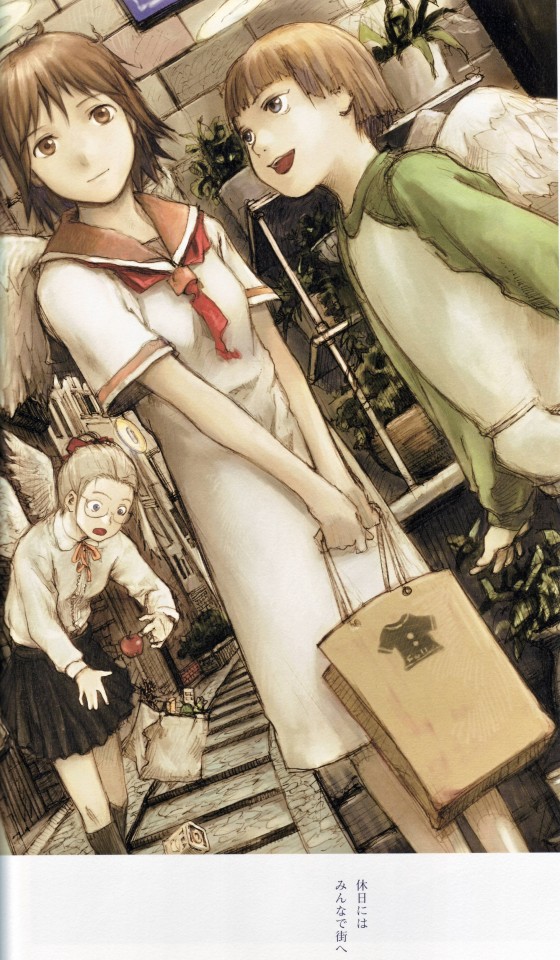



(this edit is so crazy, kind of genius)
thinking about .hack has me wanting to play infection more, i played it on my ps2 years back but that thing is always freaky with reading discs so i stopped being able to... i own infection and mutation.
this whole daydream about making textures, it will probably never bear any fruit but it's nice to imagine i suppose. it's something to think about, and at least try. i'll see how long interest lasts. since my headphones might reenter my life today... i sort of don't expect much. it's a nice daydream. if i could imagine enough textures for it i guess, enough little things to populate it with, that might help, so i guess i ought to keep daydreaming and keep notes of what things should be what or whatever.
another funny thing, i got emailed about some poetry being included in a literary review in germany, i submitted because my friend told me i ought to, and a woman on the editorial board was tapping him to send interesting writing her way because they generally didn't get enough stuff that was... idk, interesting or something, so i sent something, this was like last year, and last year this guy emailed me and i never saw, i was probably in peak hiding from my email mode because of... i don't know? the film score maybe? this was in august, i might have just been busy with something else. anyhow, he emailed me again, today-ish, and i've just emailed him back, confirming things, basically. but my name's on the site and everything, only my name is spelled wrong. which is just very funny to me, i'm not irritated at all (though i don't particularly like being a 'julian' i feel like 'julien' has given me a lot of freedom, generally, given being an uncommon spelling, idk, i've felt that way for most of my life, it's probably a strange feeling to have, still, it is a feeling i have), it's funny that my first time deciding to get published under my real name has this attached to it. hopefully the guy isn't bothered by my email or whatever, i feel really dumb for not seeing it, but i'm glad i have... stuff works out...
you can look at this, and see my real (almost) name, in issue 42 here:
i don't think it'll be available digitally so idk what i will do about the poem... it'd feel sort of mean to put it up for free on the blog since a lot of the email was the very kind man talking about how hard it is to get funding, and i have no real money to throw to them as of now, and idk... they're getting my poem... i don't feel pressure to give money especially, but if people ask me to read it i'll just send it to them, to read, in text.
i listened to this today:
among other things, but i found this good. i like the screams, the low screams not so much. creative guitar stuff, it's over in a flash, i ought to hear a couple more times for it to sink in.
oh also, i listened to this:
new from him, as always, he's very good at writing songs, i think this one i need to sit with, i need to sit with his discography more, rather than just the songs i like from him a lot, or the songs out of order, as i fall in love w/ them across the discog, as on every record he puts lotsa good songs on there, but they never feel particularly coherent in context, that's not an issue to me, but it makes the records hard to appraise in relation to one another, it feels like he's really just documenting his life here a bit, so it's like, when he's dead, that's the only time we'll have a full picture of anything.
i'm tired now and it's way way way too early. oh well! that's just my #stupid life i lead... where i sleep in the day and stare into space at night.
it also seems like my gf might no have to go to the dentist today, since it's next week, her mom was going to bring the headphones with her today, so idk if i'll get them today, i'll ask my gf to ask her mom about that but it's not particularly important.
oh well, i've gotta sleep now,
so,
byebye!!!!!!!!!!!!!!!!!!!!!!!!!!!!!!!!!!!!!!!!!!!!!!!!!!!!!!!!!!!!!!!!!!!!!!!!!!!!!!!!!
1 note
·
View note
Text
this season was kind of whack, but at least we had Eizouken
Heya Camp is just kind of a lazy reminder that Yuru Camp exists, and will continue to exist in the future. You remember these characters?? OK good, just making sure. That said, did I immediately feel the tension release in my entire body when I heard the OST? Duh. Did I sing “it’s coffee time” to the ending not knowing these were the incorrect lyrics? The entire time.
I don’t know what to do with Isekai Quartet because like, objectively, I should hate it. I do not enjoy like 2.5 of the shows involved, and the addition of Shield Hero was not a welcome one. Turns out it doesn’t matter anyway because it was just Isekai Quartet and also Naofumi is Sometimes Scowling in the Background and that’s about as much of him as I want to see anyway. And yet? I do enjoy this Disney Channel Original Crossover. There’s something inherently fun about watching these characters from disparate shows interact with each other, and no matter what the original stakes were in their respective series, they’re all just doing homework and getting part time jobs and that shit’s funny when a big skeleton man is doing it.
After its first episode, Asteroid in Love was kind of a slog. This is your typical seasonal CGDGT show, and apart from that, I really can’t think of anything to say about it. I didn’t learn anything about the Extremely Niche Topic these girls are doing, and it wasn’t even that gay. Disappointing.
I was really looking forward to Toilet Bound Hanako-kun because I am a big fan of the source material, but I was pretty let down by this adaptation. It seems that they prioritized the art style and the color scheme above everything else, but that essentially just meant the entire project ended up being colored manga panels. I wanted to see them move around! There was not a single moment of animation that justified it being an anime. You might as well have been watching a PowerPoint. I can’t think of anything nice to say. Let’s move on.
Bofuri is my power fantasy. I want to play a video game so cluelessly I break it into tiny pieces and bumble into being the most powerful player in the world’s nicest MMORPG. Maple turns powercreep into powersprint. What Bofuri lacks in character development or plot, it makes up for in outrageous Maple feats. She holds the entire world in the palm of her hand and she doesn’t even know it. She named her OP pet turtle Syrup and then turned into an alien abomination unknown to the world and went on a killing rampage. This anime was Maple Crossing Online. Love you, Maple. Wreck shit, Maple.
If My Favorite Idol Got Into Budokan, I Would Die walks a thin line and what separates it from being a slobbering idol otaku engine preaching how Cool it is to Be an Otaku and an Idol Show Watamote is the fact that Eripiyo is a girl. That’s it. If you took her and replaced her with your average Joe Schmoe-san, this show would be insufferably creepy. Every time I was waiting for it to topple over, Jenga-like, it managed to right itself and straddle the tightrope. It’s not a particularly subtle piece of media, nor does it do what I was hoping it would do and engage in any sort of conversation about the obsessive nature of idol otakudom, but you know what it does a good job of doing? Portraying being an idol as a job. Just some adults putting on underground shows and selling the same CD of like two songs over and over again. I was also hoping it would address what happened to Eripiyo, maybe talk about why at the beginning she’s dressed like an office worker and apparently gives that all up to follow this kinda-shitty idol group, why this fanatic escapism is preferable, or even maybe address how gay it is? Not in the cards, though. Honestly Budokan was, despite itself, pretty enjoyable? There are some great background lesbians. Also can we talk about how consistently good the production values were on this show? Why did this have such great dance sequences? Why did this look better than Love “Has More Money Than God” Live? Actually no I take everything back this show was kind of just Idol Otaku Watamote
Hey, let’s talk about the other idol show airing this season: the completely unhinged 22/7. This show is Whack. This show operates on an entire different plane of reality. I know nothing about the actual band, so I came into this blind and oh my god. Hey guys, the plot of 22/7 is that a Wall tells some girls to form an idol unit. A sentient Wall whose orders absolutely must be followed. Why? Dunno! What happens if you don’t follow its orders? Never elaborated on. (Actually, is this a reference to Pink Floyd? I have no fucking clue.) In any case these eight girls, summoned by a letter from the Wall, are all invited to become an idol group, and then they’re magically an idol group. It’s unclear how they become successful, how they book gigs, who’s keeping the lights on at the agency, how they’re getting paid, who HR is, how their gorilla man agent found this Wall and determined that all its directives Must Be Followed, but shit, man. What follows in 22/7 is a one-member-per-episode serial that quite frankly stumbles far more often than it succeeds. One girl’s grandma died and that’s why she came to Japan. One girl had a traumatizing experience where she got lost in the woods for a week and it broke her family apart and now things just suck forever. These things are equal. One poor girl’s entire episode was about how she didn’t want to put on a bathing suit for a photo shoot and how uncomfortable she felt about it, but in the end she was made to apologize for dragging her feet for so long and takes her photo for a pin up. Yuck. Gross. Bad. The only valid girl is Jun, end of discussion. None of this even holds a candle to the finale-- wherein the girls are directed by the Wall to disband, and, defying an order for the first time, the girls return to their agency and throw shit at the Wall until it breaks down. It’s revealed that the Wall isn’t supernatural-- behind it are tv monitors, photos of the girls as children, records of their activities. A person or people are behind this. Why??? Are they being groomed?? Is the Wall a metaphor for the Industry? I’m so concerned. The girls aren’t, though, because after a little side eyeing, they ascend a staircase and wow! A Stage! Our fans are all here for our reunion tour! And then they’re fine and I guess their idol group is back together or something? Did I mention the stage where they perform? It’s at a zoo. I can’t tell if this is the most scathing condemnation of idol culture I’ve ever watched or just completely oblivious. The characters don’t engage in any sort of thought about what they’re being put through, but they are performing their final song, the lyrics of which are about how life is just too hard to keep on living, at a zoo and I don’t think you can have that sort of thing happen unless you’re trying to make a point. Right??? RIGHT?!? Dance and sing, monkeys.
Smile Down the Runway was another show completely divorced from reality. So you got your main character, Chiyuki, whose thing is that she’s Too Short to Be a Model at her father’s very prestigious modeling agency. Which, like, is valid! Let’s see some variation in the modeling industry. Let’s shake it up. Let’s lead the charge for alternative models with bodies outside of the very narrow requirements of the fashion industry. What’s that, Chiyuki? You have no interest in that? You want to be a Hypermodel? I don’t know what that shit is, I think you made it up. Our other protagonist is Ikuto, the destitute, put upon, bobcut boy with a dying mother and 3 younger siblings who is trying to pursue his dream of becoming a fashion designer. Are you beginning to sense the problem here? There is a fundamental imbalance in the presentation of these characters’ goals and situations. Also? Emotions are at an eleven, always. Characters are always acting as if they’ve just seen someone get murdered in front of their eyes even when it’s like. There’s a messed up seam. They are constantly being mortified, crushed, and having their dreams ripped away. One time, two different assholes offered Ikuto magical mom-fixing blood money when he was struggling to come up with funds to pay off his medical debt at the cost of giving up his spot in the fashion show. Wildin’
Haikyuu didn’t exactly come in like a lion, but I’m sure it’ll be more organic upon rewatching. We were laying the groundwork for much of this season so I’m expecting it to payoff later, but the beginning definitely lagged. Every time Haikyuu hints at a women’s volleyball tournament, I want a volleyball anime with girls. Man, those ten minutes we got with Kiyoko? Those were great.
I don’t have too much to say about Somali and Forest Spirit. Abe’s “Make Children” agenda feels at least a little more like a narrative choice in this anime, and I enjoyed Somali and the Golem’s relationship and their travels were in equal turns harrowing and heartwarming. And I did tear up at the end so you got me there, anime.
In/Spectre has some balls being an anime. It’s existed as a light novel and a manga and those are both superior mediums for it because let’s put all our cards on the table here-- In/Spectre is a show about talking. Five whole entire episodes take place in a car. The finale is winning an argument in an anonymous 4chan chatroom. That said, I have such a fondness for In/Spectre. I think Kotoko rocks. I think a show willing to do nothing but talk at you for two hours is badass. Sitting through this anime is like watching a podcast. I think the show engages in some great dialogue about human nature and how we prefer stories that are theatrical, narratively-driven, and have a logical cause-and-effect, instead of the truth, which is more often than not grim, and disappointing, and illogical. I like that Kotoko’s only function, in-story and out of it, is to bullshit so hard she invents alternate realities. Anyway In/Spectre is good.
There’s no praise I can lavish on Eizouken that hasn’t already been said. It’s powerful, it’s strange, it’s energetic, and it’s packaged with such love. It’s repurposed the CGDCT template into something deeply affecting. It’s an anime for people who love animation. I hope everyone watches Eizouken.
10 notes
·
View notes
Photo


Abe Sapien: Lost Lives and Other Stories - “Witchcraft & Demonology”
Words: Mike Mignola & Scott Allie | Art: Santiago Caruso | Colours: Dave Stewart | Letters: Clem Robins
Originally published by Dark Horse in Abe Sapien #30 | January 2016
Collected in Abe Sapien - Volume 9: Lost Lives and Other Stories | Abe Sapien: The Drowning and Other Stories
Plot Summary:
Also set in 1983, Abe gets a lesson on Gustav Strobl and his book Witchcraft & Demonology from a stranger.
Reading Notes:
(Note: Pagination is solely in reference to the chapter itself and is not indicative of anything within the issue or collections.)

pg. 1 - I think this is interesting in how it continues on after Abe debriefing regarding his mission in Mexico, but changes tack to an entirely different conversation, relevant to what was going on in the present day narrative. It’s a nice way to nest disparate tales within a sequence that you wouldn’t necessarily have put together since they were released a couple of years apart originally.

pg. 2 - Bruttenholm being dismissive of Strobl’s provenance is funny. Also, I love the overall design of the book.

pg. 4 - Sure...Mallory from “research”. Convenient that he walks in to tell Abe more about Strobl just after Bruttenholm leaves.
pg. 5 - The artwork from Santiago Caruso and Dave Stewart is just gorgeous. I absolutely love the linework and the shift in colours for the flashback really emphasizes the change in time period.
pg. 6 - I’d love it if books just magically appeared if I wondered about them.

pg. 8 - This is just gorgeous. It’s also interesting to see how this dovetails in with Strobl’s return to the Black School.
pg. 10 - This gathering of witches is incredible. Reminiscent of Duncan Fegredo’s in the main Hellboy series.

pg. 12 - Love this depiction of Orobas. He’s one of the traditional Princes of Hell in the Goetia. He’s often used as one of the first evocations for people starting Goetic workings, since he’s one of the demons that typically doesn’t deceive or harm the magician who has conjured him. Leaving Strobl to believe that he’s Satan is a little out of character.
Per Aleister Crowley’s Illustrated Goetia his office is “to discover all things past, present, and to come; also to give Dignities, and Prelacies, and the favour of friends and of foes. He gives true answers of divinity, and of the creation of the world.” (Crowley, DuQuette, Hyatt, Wilson. Pg. 185)
pg. 13 - Love seeing Asmodeus. The Bride of Hell is one of those great Hellboy stories and it’s nice to see this depiction of the demon again.
pg. 14/15 - Gorgeous double-page spread. Also I find it kind of funny that Memnan Saa is more or less a footnote in Strobl’s tale. That he built himself up to be a huge and major player in BPRD: Hell on Earth but is basically a bit part in Strobl’s story.

pg. 16/17 - This is just stunning artwork. I love the depiction of Hell, complete with those vaguely European houses off in the distance that we saw in Hellboy in Hell.
pg. 18 - I would think that anyone who saw much of Europe in World War I would think they’d arrived back in Hell.

pg. 20 - It’s kind of funny what people will convince themselves of. Not even considering that maybe the object of their obsession will have other plans.
pg. 22 - I like Abe’s suspicion, and how “Mallory” just ups and disappears.

Final Thoughts:
Santiago Caruso is an Argentinian artist primarily known for his fine art illustrations for book and album covers. I believe that this is his first and only foray into North American comics, but it’s one hell of a damn good entrance. His detailed, classical illustration style with beautiful pen and ink shadows and composition are damn near perfect for this story. His Hell and demons rival that of Bosch’s Garden of Earthly Delights. Beautiful work.
It’s also interesting how this one further fleshes out Gustav Strobl’s character. It’s definitely something that better informs his history and purpose, especially as it was originally released leading into the final story-arc.

d. emerson eddy is not classically illustrated.
#Give 'em Hellboy#Hellboy#Abe Sapien#Lost Lives and Other Stories#Mike Mignola#Scott Allie#Santiago Caruso#RaisingHellboy#334
17 notes
·
View notes
Text
Video Games are a God Damned Mess: Bad Business Practices, Unsustainability, and the Fidelity Plateau
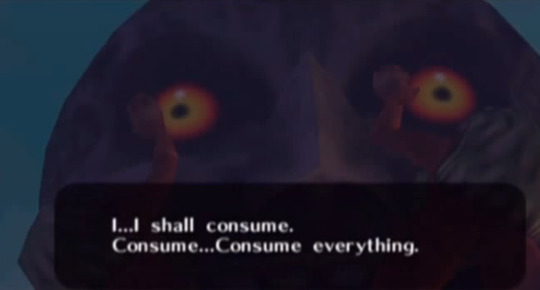
(shoutouts to the anon rando in my inbox for telling me about the read more button you were kind of rude about it but i don’t use this website so i legit didn’t know)
The video game industry has always been a bit wild and wooly compared to its older contemporaries. The emergence of a new medium is always rife with upheaval as paradigms shift and people discover that the old rules don't necessarily apply all of the time. That said, the past three months have been filled with what I can really only describe as catastrophes for many disparate publishers and development studios.
You may recall I talked a bit about this during my game of the year list and Fallout 76 analysis, but to recap: with Telltale shutting its doors and shafting its workers, the writing was on the wall for the same thing to happen again as the intrinsically unsustainable boom and bust cycle began the less glamorous stage. It turns out I was correct in my predictions but congratulating myself for seeing this coming is not unlike congratulating myself for accurately predicting that tomorrow will be Tuesday. Or. Whatever day it will be when I post this. fuck i dated the lp thread ruined LOOK the point is that this was really obviously going to happen and that nobody felt the need to prepare for it or try to stop it before 10% of Activision-Blizzard's workforce got canned is a major failure of the industry at large.
So let's talk a bit about what's happened since then. There's been a lot, so forgive me if I miss your favorite corporate implosion. First, at Blizzcon, Diablo Immortal was revealed to what actually might have been the most actively hostile reception of a game in history. This has less to do with the more financial aspects of the ongoing Videocon Crisis and more just kind of served as an ill omen and an example of Blizzard's worrying descent into... wherever it is they're going. If gross incompetence was a place, they would be descending into it. On paper, a Diablo mobile game is a money-printing proposition. When all is said and done Immortal will still probably make them gobs of cash. In practice, however, they fucked the landing so hard they probably lost potential sales. The kind of folks who go to Blizzcon and get omegahype for a new diablo game are not the kind of folks who play mobile games. Mobile games have a Stigma among the hardcore crowd, and also the Ethical Business Practices in Video Games crowd (which as of this writing appears to be me, Jim Sterling, and the Warframe devteam). For a lot of braindead gamerbros, mobile games are synonymous with things like Candy Crush and Peggle, which are perfectly fine games honestly but they're For Girls or some shit so mobile games are bad and for casuals. More pertinently, mobile games are also a ferocious jungle of microtransactions, pay2win mechanics, and generally shoddy design. Command and Conquer and Dungeon Keeper, beloved franchises that have been ripe for revisiting for years now, both found mobile games and they were both utterly terrible. These games make a great deal of their money by exploiting "whales", or in actual human being language, vulnerable people with disposable income and difficulties with impulse control or addictive personalities. Or kids who know their mom's creditcard number. Kids play video games. Now that we are no longer kids (theoretically, anyway) it can be easy to forget that. I'm not the pearl-clutching type, but I think that stigmatizing a genre of games that proudly touts an exploitative-of-children business model is probably okay.
So there are lots of reasons to be skeptical of Diablo Immortal right out of the gate, and quite frankly whoever thought that just pushing that out there with literally no other Diablo related news items (like any whispers of the long coveted hd remaster of diablo the second) was either transferred in from another company the day before or had some kind of unspeakable grudge against the scheduled presenters, to whom my heart goes out to. There is also some undeniable precedent that Blizzard-Activision will, in all likelihood, monetize the everloving daylights out of it. Both Hearthstone and Overwatch have more or less become nicely polished vehicles with which to deliver lootboxes to players for a nominal fee. If this hadn't been followed by a seemingly unceasing calvacade of disasters, the whole debacle would have been really funny to point and laugh at. It's still pretty funny to point and laugh at, but it also has some less amusing implications. Blizzard in particular has been up to a lot of no good lately. Let's talk a little bit about their recent one-two punch.
First up, we have the complete and sudden abandonment of competitive support for Heroes of the Storm. Heroes of the Storm was essentially Blizzard's seething regret and resentment for letting Valve snatch up the whole Defense of the Ancients thing put into code and unleashed upon an unwitting populace. It had actually been gaining some renewed interest over the past year or so due to the developers putting in some elbow grease and making the game both more accessible and just. More better. HotS has also had a modest but respectable eSports scene since the game's launch, with a variety of professional players, shoutcasters, tournament organizers and emergency bugfixers employed. Many of them were anxious about their jobs for months in advance with no word from the higher ups about who would still be employed by 2019. Sometimes, companies have to make difficult decisions and let people go to keep operating. Even my communist ass reluctantly accepts this as a reality of the system we live in. However, there is a protocol about this kind of thing. Giving notice. Giving, you know, severance pay. Stuff like that. And of course this presupposes that this sort of cut to the workforce is actually necessary in the first place. Given that AB subsequently reported record profits for the year of 2018, I have some doubts. Completely dropping support for a game out of the blue is a scummy thing to do to your playerbase. When it is also directly impacting the livelihood of hundreds of people in your employ, it goes beyond scummy and turns right into Unacceptable.
But "unacceptable" is Bobby Kotick's favorite word in the English language so while shoving hundred dollar bills from his latest corporate bonus up his butt he and his friends in the boardroom decided that the HotS esports people might get lonely, so they had better go and fire another 10% of the workforce too. Just because. Like literally just because. His company is doing fine - better than fine! They are at record levels of better than fine. But the shareholders demand more and more exponential growth, so to cut costs that really didn't need cutting, away goes 10%. Will game quality suffer because of this? Undoubtedly. More work being piled on fewer people who are also living in mortal fear of losing their jobs Just Because is not a recipe for success. People are mad about this, much like people were/are mad about Fallout 76 - players of games, industry wonks, and iconic voice actresses alike are no longer tolerating this kind of thing in Two Thousand and Nineteen, Common Era. Nor should they!
Elsewhere in the Game-o-sphere, similar developments are brewing. ArenaNet, the folks wot do Guildwars, went through another round of mass layoffs. EA's stocks have plummeted and Battlefield V "failed to meet expectations" because it only sold A Ton and not A Fuckin Shit Ton, and Anthem is not really lighting the world on fire. After Mass Effect Andromeda's... curious debut, Bioware has probably been feeling the heat and a lot of people are concerned that it too will suffer the ultimate fate of all studios acquired by Electronic Arts: joining Visceral Games in a broken heap at the bottom of the garbage chute. Bring back Dead Space you motherfuckers. Bethesda continues to, improbably, suffer through PR disaster after PR disaster with Fallout 76, a game that seemingly cannot stop fucking up. Ubisoft has received some positive attention for vowing to NOT lay off hundreds of employees for no discernible reason, which leads me to believe that our standards for praiseworthy behavior have dropped alarmingly low. Even 2K Games in all of its monolithic glory seems to be feeling a bit of a Stock Price Squeeze. Honestly by the time I get this done and posted it's entirely possible that somebody else will fuck something up. I'm still kind of waiting on the fallout from Randy Pitchford's porn thumbdrive, but I'm also a little bit pleased that Actual Money Crimes are getting more traction in the news cycle.
So, returning to the main point: the industry is in a bad situation of its own making. It's a scene that's almost always been defined by trend-chasing. For a while, that meant that we would just have to suffer through an endless glut of EXTREME SPORTS GAMES SPONSORED BY A DUDE or a barrage of samey console shooters desperately trying to be Halo every once in a while. Unfortunately, the trend-chasing now extends not only to the games themselves, but to the methods by which they are monetized. Ever since DLC became a mainstream thing, the brightest minds of the boardrooms have been working tirelessly to deduce which method of fleecing players will scientifically speaking get them the most money. Inevitably, when some enterprising little weasel develops a new and improved monetization scheme, the rest of the little weasels will immediately latch on to that scheme and that's how you end up with Battlefront 2's ridiculous lootbox grind and Shadow of War's ludicrous inclusion of randomized lootboxes in a singleplayer action-adventure game. While I'm certain that the platonic ideal of the lootbox has existed in some form or another for decades now, I think that we can squarely lay the blame for the Great Lootbox Plague of the Twenty-Tens at the feet of Valve.
Valve has been known for questionable business practices for a while now (albeit in a more lowkey way than We Fired 800 People So Bobby Kotick Could Buy a New Yacht), largely getting away with it because Steam has been more or less unchallenged as the premier digital distribution service for video games. This might be changing soon, as Epic Games is going straight for the jugular with a number of aggressive moves with its own fledgling platform, but historically, Valve has faced very few consequences for just kind of being petulantly antagonistic towards its userbase because said userbase is easily mollified by steam sales and Gaben memes. When people think lootboxes in 2019, they probably think of games like Overwatch or Battlefront 2 or basically any contemporary multiplayer game. I certainly do, but a bit of fact finding allowed me to remember that Valve has been doing this shit since Counterstrike and Team Fortress 2, and Dota 2's byzantine cosmetics market can't be overlooked either. All three of these games are or were at one point genre leaders and made Valve so much money they basically decided that they didn't really need to make games anymore. A reasonable conclusion to draw, given the fact all three of these games are inextricably linked to their history as very popular mods. Valve just outsources a great deal of its labor to dedicated, naive fans and gives them a pittance of the huge mounds of dollars they make from their hard work. It's a good racket, but it has set an alarmingly poor example to the rest of the gaming world.
Games as a service, in concept, is fine for games that lend themselves well to the idea. MMOs have been using a variation of the model for decades now and that genre is actually like, Perplexingly Healthy. Free to play games like League of Legends and Warframe have also had success with a service model. The problem comes from the AAA Game industry's pathological insistence on shoving square pegs into things that don't even have holes to begin with. Shadow of War, or Assassin's Creed, or any other major singleplayer offering, has no business whatsoever being a Live Service. They are finite experiences by design and that's completely fucking fine and normal. Appending microtransactions and lootboxes to them is a transparent attempt to just suck up a little bit more money from players in the most unsustainable way possible. Here is a small hint if some WB Games bigwig stumbles upon this: first of all, I'm building a guillotine, so you better watch your ass. Second, how dare you fucking make Shelob a sexy lady. Third, (this is the one that is probably most relevant): People are willing to pay as they go for cosmetics and timesavers for games that they like and want to support. I've dumped a lot of money into League over the years because there was a period of time where I was playing it nonstop and having a wonderful time for quite literally no cost to myself, so I felt like buying the cute Panda Annie Skin was a good compromise. Regrettably I would later learn that there are aspects of Riot Games I'm not super okay with giving money to but at the time they seemed agreeable and my friends who work there gotta get payed somehow. This whole dynamic of wanting to support a video game goes out the damn window when you are already charging a $60 entry fee, plus whatever highway robbery pricing you put on the inevitable DLC. In this case, the onus is squarely upon the publisher to provide an experience and content one would reasonably expect of the pricetag. Putting in microtransactions for cosmetics is galling. Putting in microtransactions for actual game progression, like in Battlefront 2 or Shadow of War, is outright insulting.
Many will leap to the defense of these publishers and developers, saying that these measures are necessary to make these ludicrously expensive and lavish AAA games that all look suspiciously like one another. For the time being, let's accept this as a true statement. If this is, in fact, the state of affairs in the industry, then the industry needs to change to a more sustainable business model. When playing Destiny 2, during a big space cutscene, the cute pilot lady ferrying me to The Large Molerat Man's Murderboat had beautifully rendered skin where you could see the pores and the little wispy cheek hairs that swayed to the momentum of the space plane's movements. It was very nice but then the next year or so I heard nothing but people pointing out "hey this game has no content you dipshits" or "the devteam is actually scamming people with the experience system to wring more playtime out of them". The cheek hairs affair succeeded in making me want the pilot to buy me dinner and regail me with stories of her space adventures as I batted my lashes at her in romantic admiration, but also: stop it. You do not need to do this. This is strictly unnecessary. The graphics arms race of yesteryear is over. Nobody cares anymore. Fidelity is plateauing harder and harder, to the point where games running properly on console without having to settle for 30FPS is becoming very difficult. There is an Earth B somewhere out there where Bloodborne was not a sony exclusive and got a PC release with 60FPS support and loading times for humans and on Earth B I am still playing that game for the forseeable future because it is the best game ever. We are far past the paradigm where we are making Tremendous Graphical Leaps with each successive generation. Right now, as of this writing, games look jawdroppingly good. Just ludicrously pretty and grandiose. Continuing to push the graphical envelope for Every Damn Annual Release is a waste of resources: monetary resources, labor resources, system resources. As of March, 2019, what people really want is stability and functionality. Something that runs nice and smooth at 60FPS and doesn't turn its characters randomly into nightmare inverse-Rayman beasts. I think the huge success of the Nintendo Switch, a console with relatively modest hardware but superb functionality, portability, and a surprisingly full featured library of both massive first party titles, like Breath of the Wild and Mario Odyssey (which honestly look better than a lot of games on more robust hardware because of wonderful art direction) and smaller indie games, is testament to this line of thinking.
Maybe that's too bold of a statement. Maybe there's this huge swath of the gaming public that is just clamoring for more cheek hairs. If there are I think they're fucking out of their minds but who am I to judge. As long as games like that werewolf game The Order exist, where the universal reaction is "this is so pretty!!! ...wait there's nothing in here." I think that there is a serious responsibility to push back against that because evidently it's bankrupting the game industry and forcing them to violate international gambling laws to stay afloat. Except it's fucking not, actually. Many publishers are claiming record profits, upward trends, and are in a spot to have the raw nerve to say "well this game that sold 7 million copies didn't sell 8 million copies so it failed to meet expectations". They are doing ludicrously well for themselves in terms of generating revenue from sales. Where these highly successful corporations are running into problems is satisfying the almighty Shareholders. Shareholders are sort of like. Imagine if you got a job where you had to keep a large committee of actual babies happy, except the babies don't know shit about fuck about anything and demand that you routinely break all reasonable laws of sustainability and keep bringing in exponentially higher profits or they will take their ball and go home. There is still, evidently, money enough to give newly hired executives million dollar signing bonuses, but when it comes to just making a game that doesn't fall back on exploiting people with gambling addictions, we're suddenly dealing with an outfit of noble, longsuffering churchmice just trying to make ends meet. People are rapidly getting fed up with this blatant hypocrisy and dishonesty. Sales from Hearthstone card packs alone could fund a robust HotS esports scene for eternity if properly apportioned. This money is not properly apportioned. It is thrown into a gigantic incinerator so Kotick can get high on the fumes.
You might be wondering what this girls' deal is with Blizzard. Surely there are more egregious offenders? Firstly, Blizzard is very relevant at the moment because they are one of the highest profile publishers to recently Do A Business Oopsie. Secondly, I live in Irvine, California. Blizzard HQ is a ten minute drive from where I live. It's a local company to me, and it's legitimately kind of hard to see it continue to go down this path because I've had friends and neighbors who have worked there and enthusiastically described the experience right up until the very moment they get canned for no reason. My alma mater, UC Irvine, is one of the leading schools in the nation on adopting eSports into their collegiate athlete program. I understand, to a lot of people, Electronic Sports (please support them) are a big joke silly thing, but to me and my family who work in the UC system, they're actually like a huge and pertinent part of professional life. I'm literally being consulted by my mom's co-workers for advice and insight on how to minimize the abusive and toxic behavior that has become synonymous with streaming and professional gaming because campus now has a huge eSports center with rows on rows of gaming computers for students to use. Games Are Big. They are a powerful cultural and economic force in the lives of millions of people and denying that because of "haha nerds" is the same shortsighted, utterly-lacking-in-self-awareness wanking that resulted in the stupendously destructive "its just the internet, it doesnt matter lol" attitude that has caused the world so much grief. That said Bart Simpson becoming an esports legend sponsored by Riot Games is still pretty lame don't @ me.
What it comes down to is this: the games industry has grown into a hugely influential and powerful institution that affects the lives of more and more people every day. However, the appropriate growth in regulation, oversight, and worker protection has not occurred and has honestly shrunk. People love to talk up Satoru Iwata because when the Wii U was floundering he took a massive pay cut and refused to lay off any staff, reasoning that "it will be very difficult for our teams to create software that will impress the world when they are constantly worrying about losing their jobs." It's a little incredible that The Baseline Reasonable Thing To Do has elicited such effusive praise, but that's the world we live in and Iwata-san was pretty alright so I'm okay with it. Both his conduct and reasoning are both solidly above reproach in this case: it is really hard to be creative when the Sword of Damocles is hanging over your head! That’s 500% true! This goes for game developers, community managers, eSports staff, support staff, literally every part of the process that matters, even the totally unrelated clerks and communications people who are still completely necessary for creating games. The only people who don't suffer are the dipshits on top who don't actually contribute to the creation of games in any way. They're still fine. Better than fine, really. That's why people are mad. That's why people SHOULD be mad. Don't stand for this anymore.
9 notes
·
View notes
Text
The Oral History of Documentary Now’s Co-Op Episode

IFC’s brilliant, demented, and insanely detailed series “Documentary Now!” returned for its third season last month with an excellent premiere, the two-part “Wild Wild Country” sendup “Batsh*t County.” But it’s the season’s second episode, “Original Cast Album: Co-op,” that truly raised the bar.
As usual, the episode expertly captures the environment, style, cinematography, tone, and spirit of its source material, D.A. Pennebaker’s “Original Cast Album: Company.” Like the original, it captures the recording of a cast album, here “Co-op,” a musical written by Simon Sawyer, a Stephen Sondheim stand-in (John Mulaney) and directed and produced by Howard Pine, taking the place of Harold Prince (James Urbaniak). Also like the original, it chronicles the frustration, exhaustion, glee, and almost tyrannical attention to detail required to immortalize this particular work of art.
But unlike Pennebaker’s film, the score for “Co-op” didn’t already exist. So the “Documentary Now!” team had to somehow come up with a fictionalized version of a complex, notoriously difficult score written by one of the greatest American songwriters of all time. Easy, right? Just get someone who can imitate genius without turning out music that sounds hollow and phony. No problem.
As it happens, it was no problem—it just took a lot of work. The score for “Co-op” is funny, as a parody should be, but is also excellent on its own terms. RogerEbert.com spoke with showrunners Rhys Thomas, Alex Buono (also the episode’s director), composer Eli Bolin, and actor Richard Kind to understand how, exactly, you go about imitating Sondheim, and how you wind up with something that stands on its own two feet, in an elevator, going up.
This oral history is comprised of interviews conducted at the Television Critics Association press tour and by phone, each edited and condensed for clarity.

How the episode came about—“This pure, distilled form of Mulaney”
Alex Buono, director/co-showrunner: Company had come up in [discussion for] season two, and was definitely on [John] Mulaney’s shortlist. Like, “I will make this episode.”
Rhys Thomas, co-showrunner: We thought it was practical as well … We knew it was all in that one contained environment. And Mulaney went away and kind of stewed on it for a year, and came in [and said,] “I know what this is.”
AB: This pure, distilled form of Mulaney. So he wrote the episode, and Seth Meyers came in and helped him write some of the songs. And Mulaney wrote with Richard Kind in mind, and with Paula Pell for the Elaine Stritch sort of role ... I think it was in his original outline, “This will be Richard, this will be Paula.”
RT: Initially there was a notion that it would just be a series of songs, and through the episode, the audience would be required to try and figure out what hell this musical was. They would just be very disparate songs, no identifiable theme. And that would be the fun [of it], this bizarre picture that would emerge. But once he started writing it, the idea of the co-op became so specific.
AB: It's funny, because we could have easily predicted that he would write a musical about New York real estate. It’s one of his pet themes.
RT: It being practical—That’s our naivete. Like with “Mr. Runner Up,” the Bob Evans one, initially our motivation was, “Oh, it’s just a bunch of his still photos, it’ll be really easy,” and then we ended up shooting over 20,000 stills over god knows how many, days, and Bill [Hader] went through millions of costume changes, and it was so involved. Then with this one, you see the one location, and you think—
AB: “How hard is that? It’s just people singing.” I will say, having our four main cast members as experienced singers, and obviously Renée [Elise Goldsberry] and Alex [Brightman] in particular, was really a godsend, because they just came in and taught us how to do it.
Richard Kind: There was no difference in preparation [between doing “Co-op” and a full musical.] No difference whatever. We were doing another musical. It might as well have been “The Producers,” except it was called “Co-op.” And this is a scripted story, so we’re doing a 24-minute play.
AB: In previous seasons, we were picking from the low-hanging fruit, the most famous documentaries ever made. Company, if you’re not a theater nerd, you do not know what that is.
RT: And it’s hard to find!
Eli Bolin: I’d seen [the documentary] many, many, many times, starting in college. I love it. Everybody's microphones are picking up everybody else, everything else. There's this big like echoey mishmash of sound ... And to see the drama and the interplay, to get to be a fly on the wall for something like that. It's very moving in a lot of ways too, especially the Elaine Stritch sequence. It's funny in some ways, but really dark and sad, because she's really struggling. It runs the gamut of every emotion—and then the music is so good.
AB: The Pennebakers have been incredibly supportive. We did a Pennebaker documentary [“The Bunker,” a parody of Chris Hegedus and Pennebaker’s Bill Clinton campaign doc “The War Room”] in the second season. They were very involved in this one. We’d send an email saying, “How did you do this, how did you light it,” [and they’d respond.] And Fraser was just telling me that Criterion reached out to them, and they’re going to rerelease Company.
RT: I like to think it’s because of us.
Finding someone to write like Sondheim—“Do You Hear the Cookies Crunch?”
AB: John and Seth wrote the lyrics. Eli Bolin was our composer, he’s a Broadway guy.
EB: I didn’t know that they were going to be making this until I was basically offered the job. And my friend Alex Timbers, also friends with John, he directed “Oh, Hello on Broadway” and directed “Kid Gorgeous”, John's Netflix special. And I guess John had asked him for a recommendation for someone to write music for this, and Alex, bless his heart forever, recommended me and John just took his word for it. Totally fantastic.
AB: [Eli] has a skill set sort of like what we developed at “Saturday Night Live” in the film unit, where every week was a different style of film. Eli Bolin kind of does that in the Broadway world. He’s just so versatile.
EB: I’ve spent a lot of time writing in the world of sound-alikes. At “Sesame Street,” for example, I've been at “Sesame Street” for eight years, and recently I had to write a bunch of music for Cookie Monster that sounded like “Les Misérables.” You know, “Do You Hear the Cookies Crunch?” instead of “Do You Hear the People Sing?” But it couldn't be “Do You Hear the People Sing,” it had to be an original composition that highly suggested “Do You Hear the People Sing,” while completely and legally being a new song.
AB:: So when we said, can you do something in the Sondheim style? He said, yes, I could do that.
EB: I've been listening to [Sondheim’s] music for 25 years. More, really, since I was a kid. I love all of his shows. I love the obscure stuff. I love the cut songs. I’ve got all the books of his lyrics. I've got books and books of his sheet music, and collections, and full scores to his shows. I love him. So once I like sat down to do these songs, it didn't seem that crazy to me… I felt very, very deeply familiar with the language. So it was like my first attempt to try and speak in that language, after having listened to it for 25 years.
AB: We really lucked out in finding Eli.
The writing process—“I’m going to try singing it into my phone, forgive me.”
AB: You’d get these emails from John, with a reference song ... he’d say, “Here’s some lyrics, this should sound like “Another Hundred People,” I’m going to try singing it into my phone, forgive me.”
EB: There would be a draft of a lyric first, and then I would take that and write a piece of music. The music was always different [from the corresponding song in “Company”] with the exception of Seth’s song [“Holiday Party,” modeled after “Getting Married Today”]. All of John's stuff was written to [the tune of] a song that's different from the moment in “Company” that it's trying to emulate.
AB: And then he would hear the songs that John is singing into a phone, and go and he would just turn it into Sondheim.
EB: The biggest difference between me and Sondheim, other than the fact that he's a timeless genius of course, is that he's a very trained musician and I'm mostly self-taught. So a lot of me trying to emulate Sondheim is me just listening and trying to sink into the style that I'm listening to. There's no mapping it out intellectually for me, which some composers would do. It's really just the decades of listening and absorbing his music.
RT: It was kind of amazing. We’d send them, then he'd send back, “here's my interpretation,” and they would sound so much so fleshed out already.
EB: With Seth’s song, he didn't write syllable for syllable to “Getting Married Today”—there’s a little more room for breath in what Seth wrote—but that one is definitely more specifically an homage to “Getting Married Today” than any of John's songs are to specific moments.
AB: Eli’s wife [Allison Posner] is also a singer, and helped him come up with all of the harmonies. So the two of them would sing on these sort of temp tracks and send them back to us.
EB: With John’s songs in particular, I would write music that didn't have to adhere to the rhythms that John initially wrote. So there would be a back and forth, and the lyrics would shift and change. For example, the opening number, the “Co-op” song, John wrote his lyrics to the tune of “Skid Row” from “Little Shop of Horrors,” and then I wrote music that was sort of inspired by that, but also sort of inspired by the opening number of “Company.” Then working with my collaborator Mike Pettry, who did the orchestrations—he pushed it even further into the territory of sounding like the opening number “Company.” So it has that feel, even though that's not what John wrote to.
AB: Mike Pettry, the orchestrator, he was almost like this Broadway historian. Like, “Oh, well, in 1971 the orchestra would have included this many people, and they would have played these instruments.”
EB: Mike also plays the conductor in the episode. It was very helpful to have someone connected with the music actually conducting the singers on the set. It was absolutely crucial.
RT: The whole story of our show is these lucky … [shrugs, nods] “Ah, okay, yeah!”
AB: “Thank God we found you, because we don't know.”
EB: [Imitating Sondheim’s sound] wasn't something that I necessarily even plotted out in any kind of deliberate way. John was already emulating [his sound]—other than “Skid Row,” everything that he used was a Sondheim song, and there's definitely a “patter-y” quality for most of the lyrics that he wrote. With Renée’s song [“My Home Court”], for the verses, he picked it very languid song, “Multitudes of Amys” [which was cut from “Company”]. And then for the chorus, he picked a patter song, “Pretty Little Picture” from “A Funny Thing Happened on the Way to the Forum.” If it's in the rhythm of the words already, there are a handful of musical tricks that Sondheim comes back to.
On “Christmas Tips,” the patter song to end all patter songs
AB: Richard’s song, the doorman song, is longer [than on the episode]. We had to cut out a bunch of it. There's just more examples of how angry he is at his tenants.
EB: When I recorded the original demo, I simply punched my voice in at different places because there was no room for me to breathe. So I would just record a couple of lines and stop. And then I would start recording from the place where I left off, because I couldn't breathe.
RK: I had to make definite decisions: When I served the lyrics, when I served the joke, when I lost my breath. So I had to specifically say, “I lose my breath here, and this is how I do it”.
EB: It’s is pretty much an impossible song to sing, or at least highly, highly difficult. The only specific game plan was for it to be a total flood or torrent of words.
RK: I learned the song perfectly, then imposed the breath. And it was tough. The more you practice and rehearse and sing, the more breath you lose. So I had to work hard. You know, I can do a song. It was tough.
EB:: We had to find places for him to breathe in rehearsal, because we really wrote it with no respect for where a human being might actually need to breathe. And it gets progressively harder to sing as it goes, and it gets progressively faster as it goes. Especially that last section, there really is no room to breathe whatsoever.
RK: Those are such brilliant lyrics. that John wrote, I wanted people to hear them. I said, “Let's let me take breaths in order to serve the lyrics, so everybody hears the verses.” You do, “One, two, three,” everybody knows what the lyrics are, you get to [the chorus] and we've already done it so I can lose my breath there.
EB: If it is singable to any extent, it just needs to get faster and faster until it becomes exhausting for the performer.
RK: Have you seen Megan Mullally do “The Man That Got Away”? Incredible. I went to college with her, so I know how good [she is], it doesn’t surprise me that her breath control and phrasing are spectacular. I don’t have that. I’m not that girl. I lose my breath too easily, so it wasn’t so tough.
RK: With this character, there’s that line, “Am I bad at singing and acting?” That’s what this is. I like to call it, “I have a huge ego and no confidence.”
Favorite songs and Sondheim
RT: I like “Going Up,” because of the evolving story within it. Just everyone coming in. I like it when Paula’s lover gets in the elevator. And the kid!
RK: I was in an original Sondheim musical [“Bounce”]. I never thought I’d be in one. I don’t know if I could handle “Sweeney Todd.” “Sorry Grateful” was an audition song of mine. “Into the Woods,” I could do the Storyteller, maybe… They’re doing it at the Hollywood Bowl this summer. I’d be good. But they’ll get a really big star who doesn’t sing. They’ll get Kelsey Grammer. But I’d be good at it, because I know how to tell a story.
AB: I like “Cocaine Tonight” [“Holiday Party”]. Just lyrically, and the performances are so incredible. I love it when Alex and Renée start to sing together. I just couldn’t get over it.
EB: I do have a favorite. “My Home Court,” which Renée sings, and I don't have any good reason for it other than I really liked the music for it. I think it's pretty. There's no reason for it deeper than that. I'm really happy with how it came together ... And then to have somebody like Renée Elise Goldsberry sing your music is just out of this world. Having her voice singing on something I wrote is just mind blowing to me.
AB: You know Renée’s song, about decorating her apartment? So the real song is literally like two or three minutes longer than that. She just keeps going on and on and on, which we shot. We just had to cut it down for time. But the full song is on the album.
RK: Paula’s number is brilliant. Her character’s truly based on Elaine Stritch. And her song has the same, breast-beating torch song quality. That’s the only thing that really comes from the Pennebaker documentary, is her performance. Paula’s brilliant. As a performer, as a writer, as a person. No one better. Hers is not that tough to perform, except for emotionally. Because she gets to breathe!
from All Content https://ift.tt/2H23v7a
5 notes
·
View notes
Text
Okay some thoughts now that I’m a little more coherent
First of all I think it’s easily GDT’s best movie. Easily. It’s SUCH a beautiful movie I can’t even find words. Visually, stylistically…it manages to be surreal and real at the same time??? But it’s also wickedly funny to the point of bordering on black comedy at times which I was not at all expecting and was pleasantly surprised by. I don’t know how this dude managed to seamlessly blend so many disparate genres and styles in one fucking movie but he did and it worked!!! Romance, magical realism, satire, Cold War thriller, even homages to old Hollywood!!!
The characters are everything. ELIZA IS EVERYTHING like she’s so fucking snarky and adorable and bold and queen of my life forever. the supporting cast is equally stellar esp Octavia who killed it as usual and the way they interacted was just The Best.
The Asset as our fishy prince is called is so fucking beautiful. SO BEAUTIFUL like I know a lot of ppl are talking Abe Sapien but I see a LOT of Thane too. The way he moves has a kind of regality (which Doug Jones said during the talk was v much intentional) and magnetism. No, he’s not human. At no point does the movie let us forget it, which I LOVED. but there’s nonetheless a humanity about him. And while there are comic moments the relationship itself is not the butt of the joke. The chemistry between everyone is amazing in general but in particular Jones and Hawkins sell it so well I just. I ship it sfm
Minor spoiler: we don’t actually see the d, and the love scenes are more Mass Effect-y than what we were being told. I’m hoping for an uncut Blu-ray 👀
Also a couple of content warnings, something upsetting happens to a cat (it’s quick and mostly played for black comedy, I was able to handle it which says something). The villain is a racist sack of shit who tries to harass Eliza (nothing happens and it’s very brief scene)There’s a couple of gory parts because I mean it’s Del Toro but it’s not nearly as bad as Crimson Peak in that respect.
I have way more to say but I’m exhausted and cold waiting for the bus but tl;dr this movie matches the hype and thensome, go see it
30 notes
·
View notes
Photo

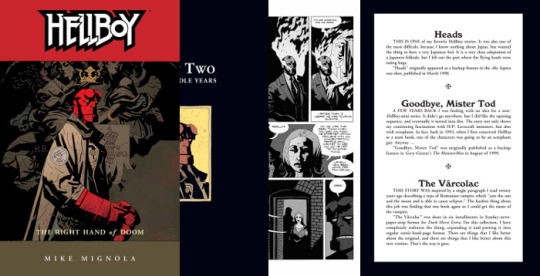
The Right Hand of Doom: Part Two - The Middle Years
“Heads”, “Goodbye, Mister Tod”, & “The Vârcolac”
Words & Art: Mike Mignola | Colours: Dave Stewart | Letters: Pat Brosseau
“Heads” - Originally published by Dark Horse in Abe Sapien: Drums of the Dead | March 1998
“Goodbye, Mister Tod” - Originally published by Dark Horse in Gary Gianni’s The MonsterMen | August 1999
“The Vârcolac” - Originally serialized by Dark Horse in Dark Horse Extra #14-19 | August 1999 - January 2000
& Redrawn for Hellboy - Volume 4: The Right Hand of Doom | April 2000
Collected in Hellboy - Volume 4: The Right Hand of Doom | Hellboy Library Edition - Volume 2 | Hellboy: The Complete Short Stories - Volume 2
Plot Summary:
“Heads” - In 1967 in Japan, Hellboy encounters a house of ill repute where demons look to feast upon him while he sleeps.
“Goodbye, Mister Tod” - 1979, Hellboy’s stateside in Portland, Oregon, investigating the case of a medium whose calling went a little bit weird.
“The Vârcolac” - In 1982, Hellboy tracks down a vampire who has eluded him before and while caught in her thrall, she introduces him to the king of the vampires.
Reading Notes:
(Note: Pagination is solely for these stories themselves and is not indicative of anything found in the original publications or collections.)
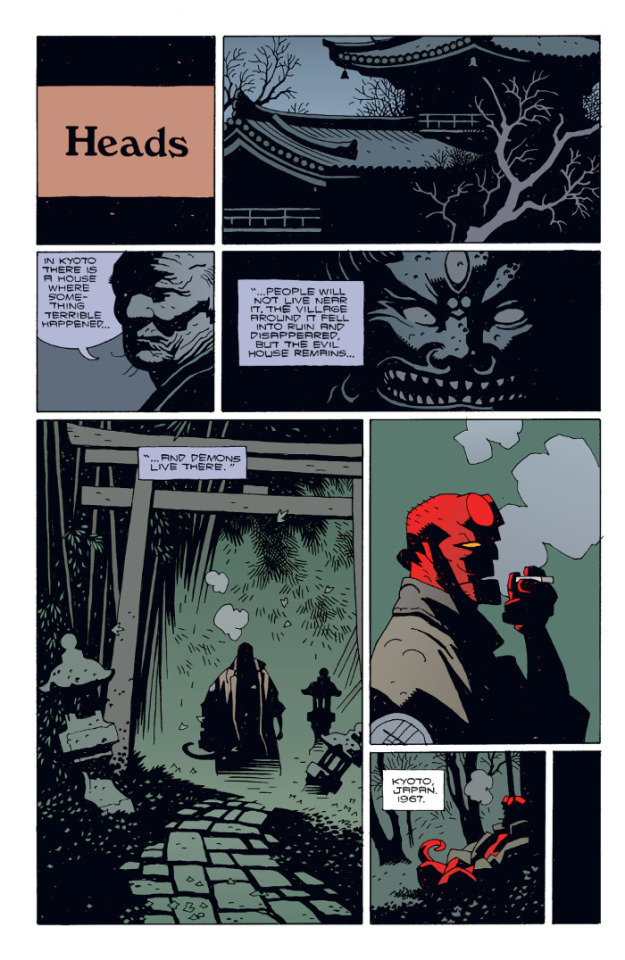
pg. 1 - You’ll probably hear “this is one of my favourite pages” and “this is one of my favourites stories” a lot while we go through Hellboy, since in one way or another they’re all my favourites. But really, this is both one of my favourite pages from one of my favourite stories. Nonchalant, cigarette-smoking Hellboy amidst Japanese architecture and statuary is just beautiful. Mignola is a master at setting atmosphere and it really shines through here.
pg. 2 - Hellboy being awakened by a stick to the head is hilarious.
pg. 3 - This is supposed to be a “funny story”. It’s great how Hellboy just deadpans it.
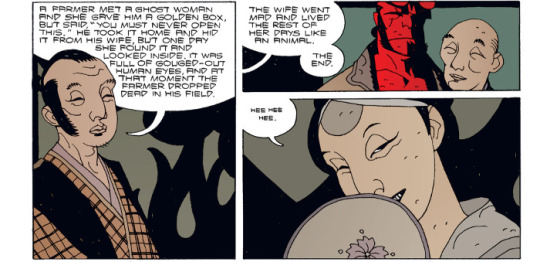
pg. 5 - Speaking of favourite pages, this is just beautiful. The final panel on the page in particular. Great use of silhouette and colour from Dave Stewart. The silent panels giving establishing shots and momentary breaks also help give a definite Japanese feel to the overall story, while Mignola uses these types of panels and sequences in his regular work, the approach here definitely seems to show an influence from manga.
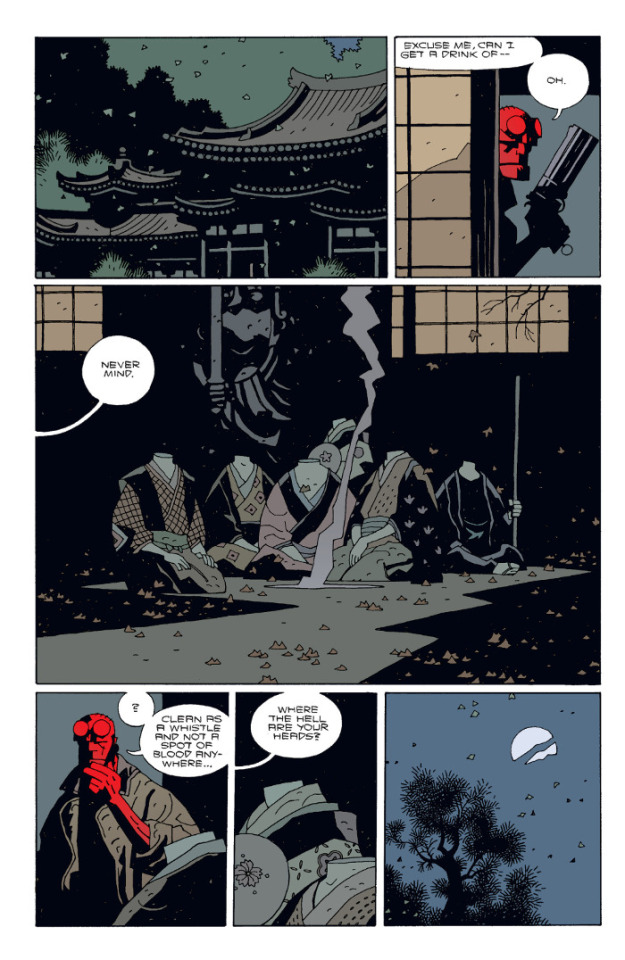
pg. 6 - No explanation for Hellboy’s actions here. I find it funny that Mignola just rolls with it.
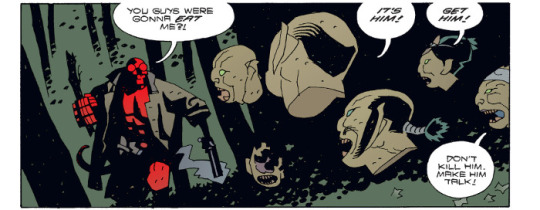
pg, 7-10 - And then we get the battle with the flying heads. Still no explanation or exposition as to what’s going on with these creatures, just a follow through with their defeat. I like that Mignola doesn’t hand hold the reader through the story, instead leaving up the details to be discovered by the reader on their own should they wish to.
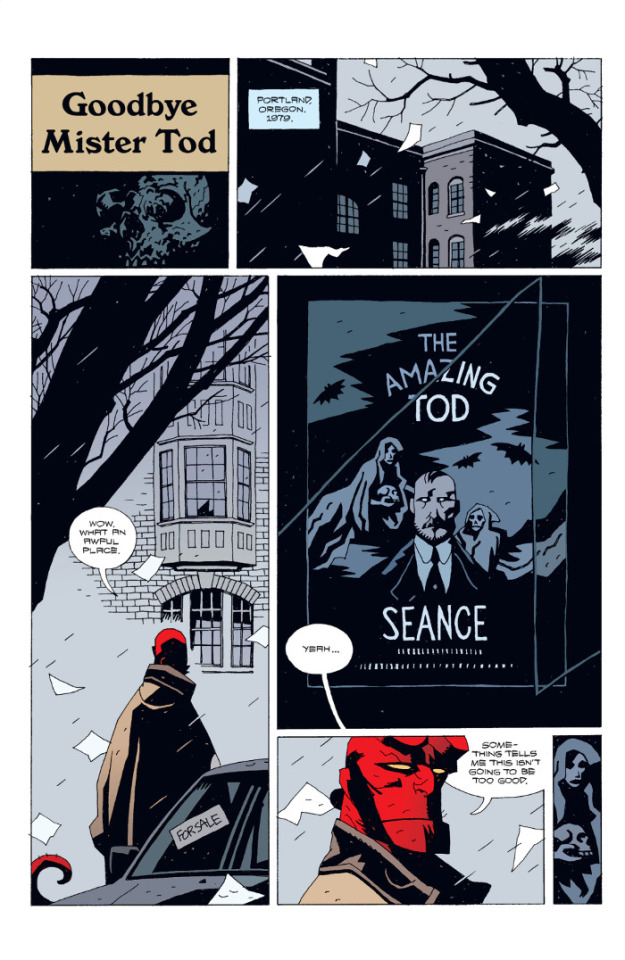
pg. 11 - Although they were taken from entirely different sources, I like that “Heads” and “Goodbye, Mister Tod” have similar layouts for their introductory pages. It adds a little bit of visual consistency to these disparate tales taken from Hellboy’s history.
Also, for those unaware, Tod is death in German. So, it’s basically “Goodbye, Mister Death.”
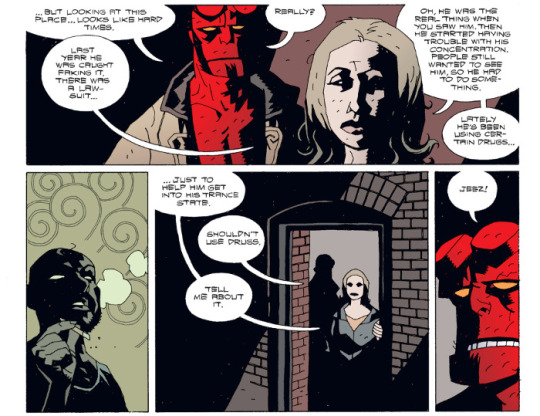
pg. 13 - I’m not sure if this is what Mignola is going for, or if it’s just meant as a “don’t do drugs” message, but there’s an accuracy here in that it’s generally not a good idea to mix drugs and magick. I know many will spout off about the hallucinatory and transcendental experiences that they can have mixing magick and hallucinogens, but it ruins a controlled experience. You’ll never know if what you experienced was the true intent of your working, or just fantasy brought on by the drug. You also might not like what you find there, and because your experience was achieved artificially, you haven’t the skill to bring yourself out. It can also become a crutch. Instead of going through building up your own personal acumen, you’re instead giving that up to a substance that may or may not kick you into an appropriate mental state.
pg. 14 - Mignola kind of explains some of this in Hellboy’s reaction. Also a fairly horrifying and interesting explanation for ectoplasm.
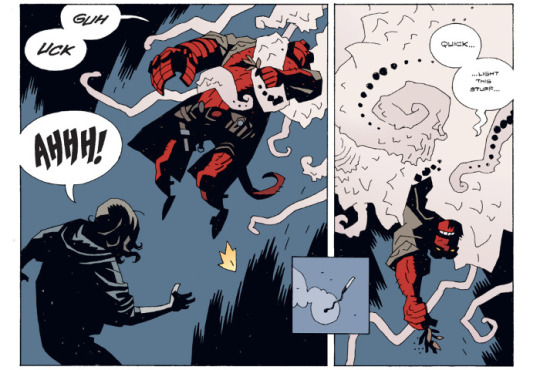
pg. 16 - Naturally, it fights back. Hellboy fighting a bunch of spectral tentacles is hilarious.
pg. 18 - As is the end result as the ectoplasm is forced back into Mister Tod’s body. The deadpan humour of “we did get rid of the creature” after Tod’s explosion is wonderful.
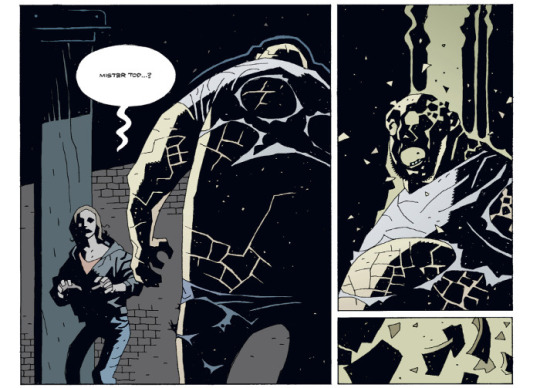
pg. 19 - This one was original published in Dark Horse’s Dark Horse Extra teaser that was done in a newspaper style, thus meaning that the comics were landscape rather than portrait. My memory may be failing me, and I’m unable to find what I did with it--there’s a hole on my shelf where it should be, but I think the original format was re-published in The Art of Hellboy.
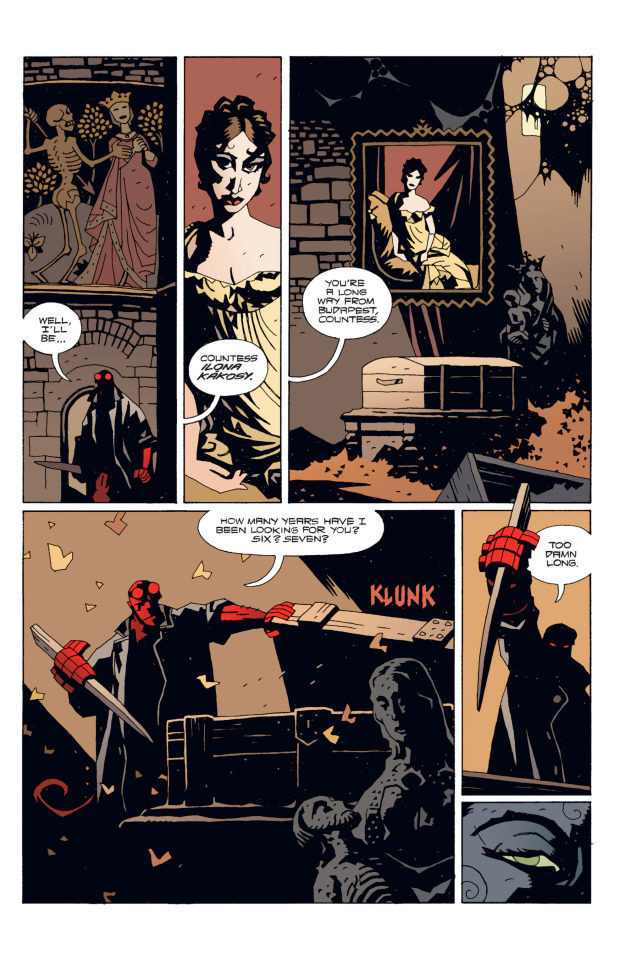
pg. 20 - Love the layouts here.
Also the introduction of Ilona Kakowsy, a kind of Elizabeth Bathory type vampire.
pg. 21 - The falling through the floor gag never gets old.
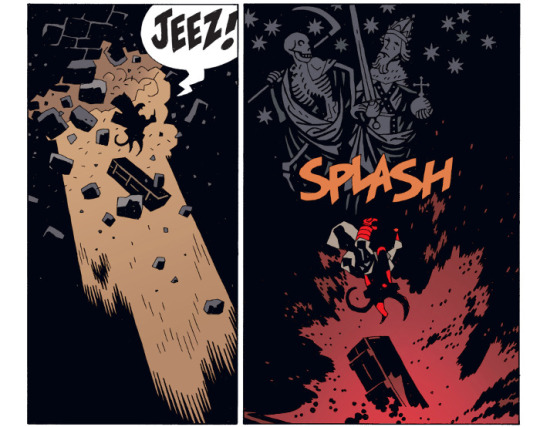
pg. 22-25 - Hellboy’s capture and plight here is one of the more one-sided that we’ve seen, but it’s always interesting to see him fail in rather humorous ways. It gives that sense of victory all the more oomph when he finally achieves it.
pg. 27 - The idea of a giant vampire that serves as king of all of the different breeds of vampires is ridiculous, but Mignola makes it work.
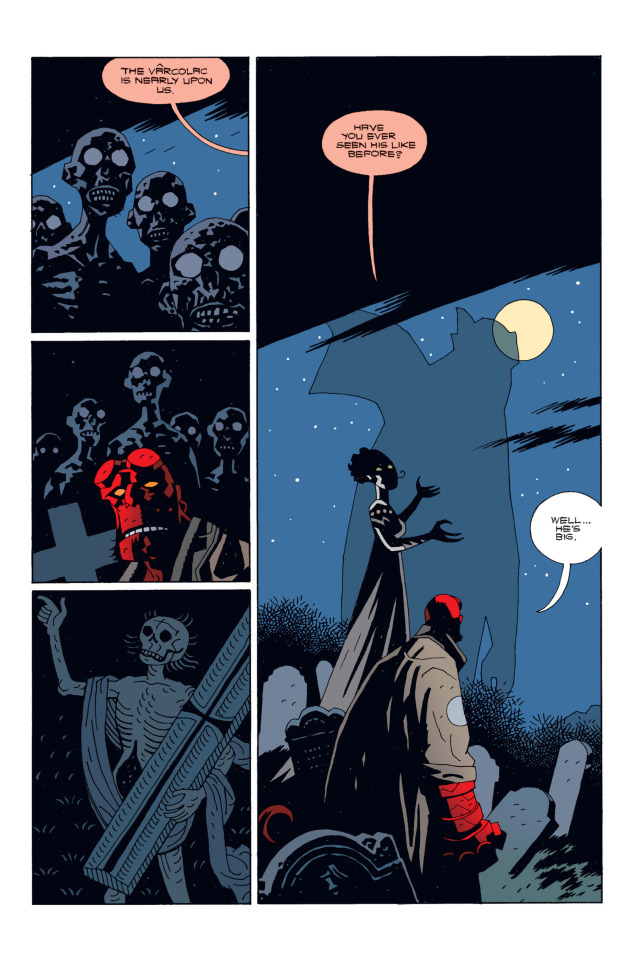
pg. 30 - Probably one of the best conclusions to a Hellboy story. This is one you should definitely experience yourself, I don’t want to spoil it with any snippets or further commentary.
Final Thoughts:
Mike Mignola is great at writing these short stories. Not only do they give us an entertaining little piece of Hellboy’s history, but it’s exciting to see the different cultures and folklore influences come out in the stories. As I said in my thoughts on the first part, it gives us a more holistic view of Hellboy outside of just the main narrative.
It’s also interesting to see him take on a more known folktale like “Heads”, involving the Japanese floating demon/vampire heads. There are also Korean and Chinese variations on this one, and Dark Horse recently published another variation on it in the late Anthony Bourdain’s excellent Hungry Ghosts with Joel Rose, Mateus Santolouco, José Villarrubia, and Sal Cipriano.

d. emerson eddy’s head does not detach at night and fly around searching for food. His body is usually attached. And will predictably wind up at McDonald’s or Tim Horton’s. Please don’t stake him. While he’s not a vampire, either, it will still kill him.
2 notes
·
View notes